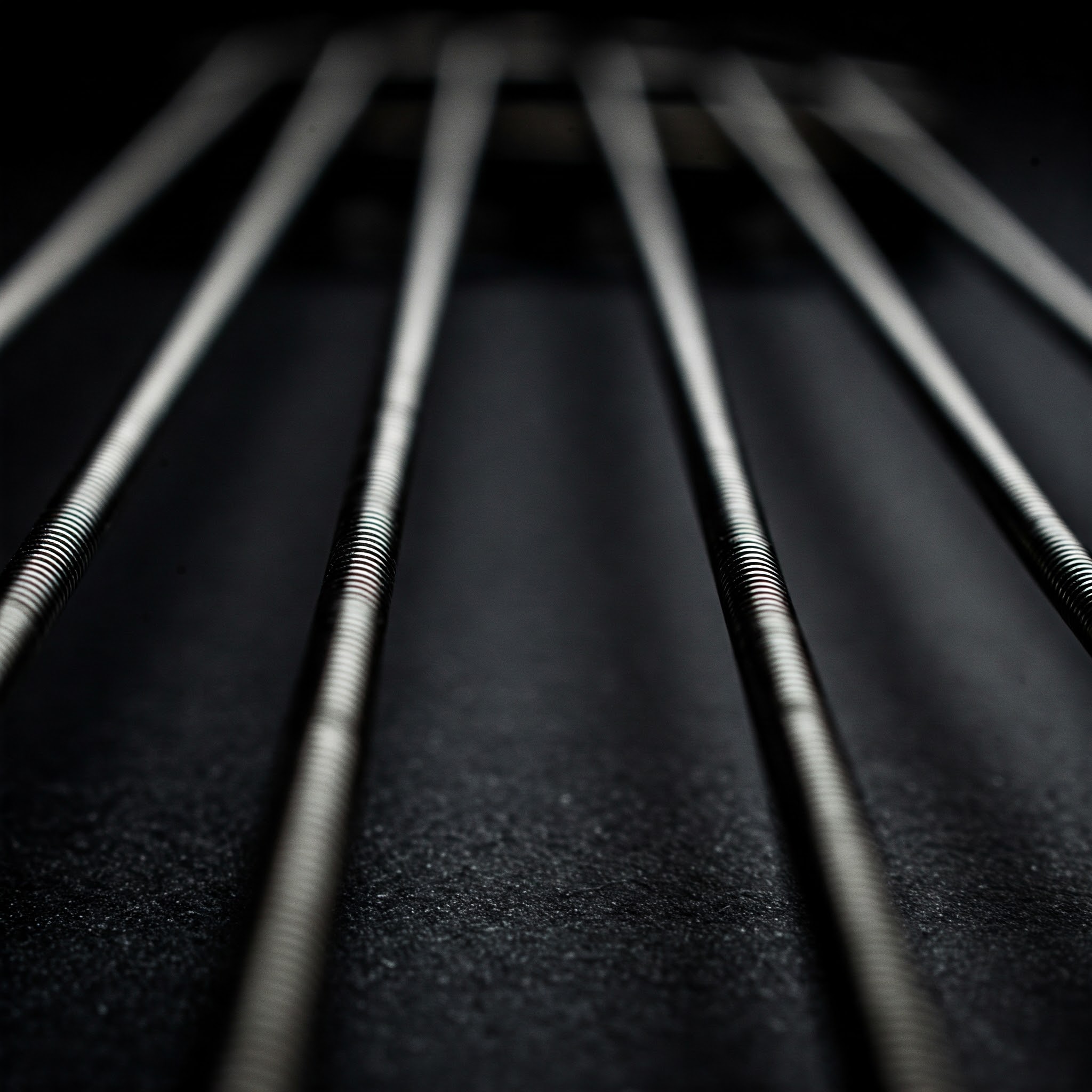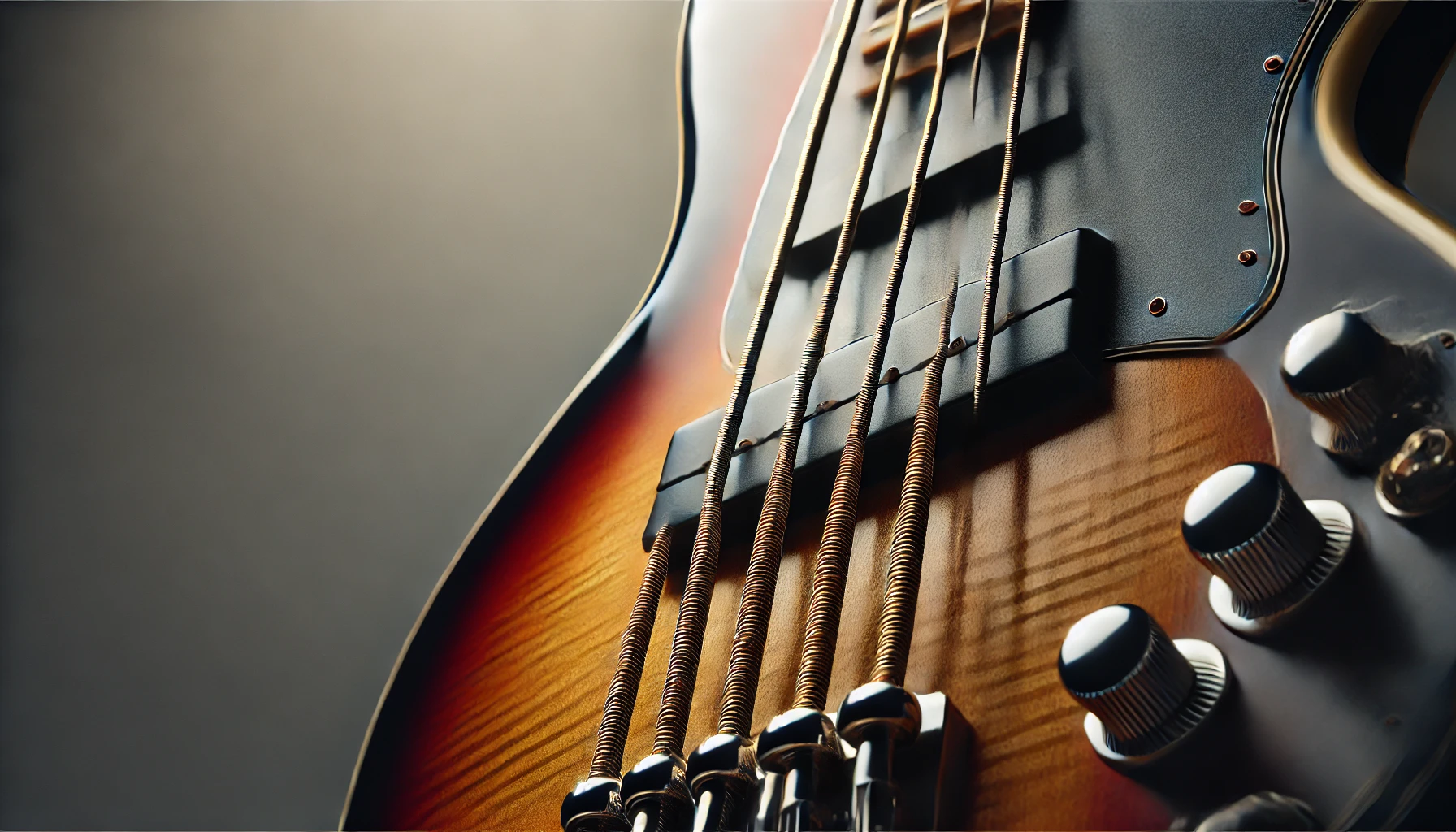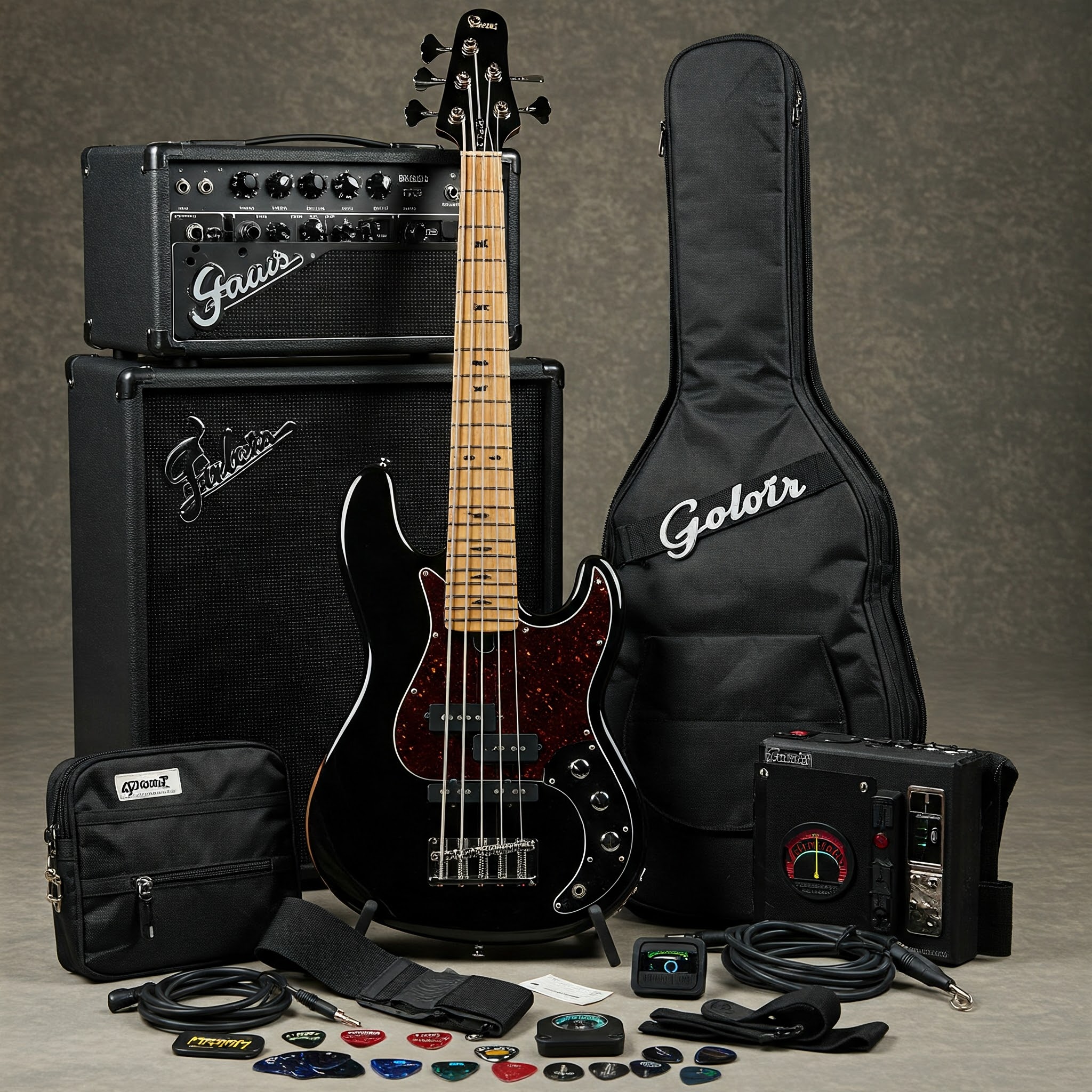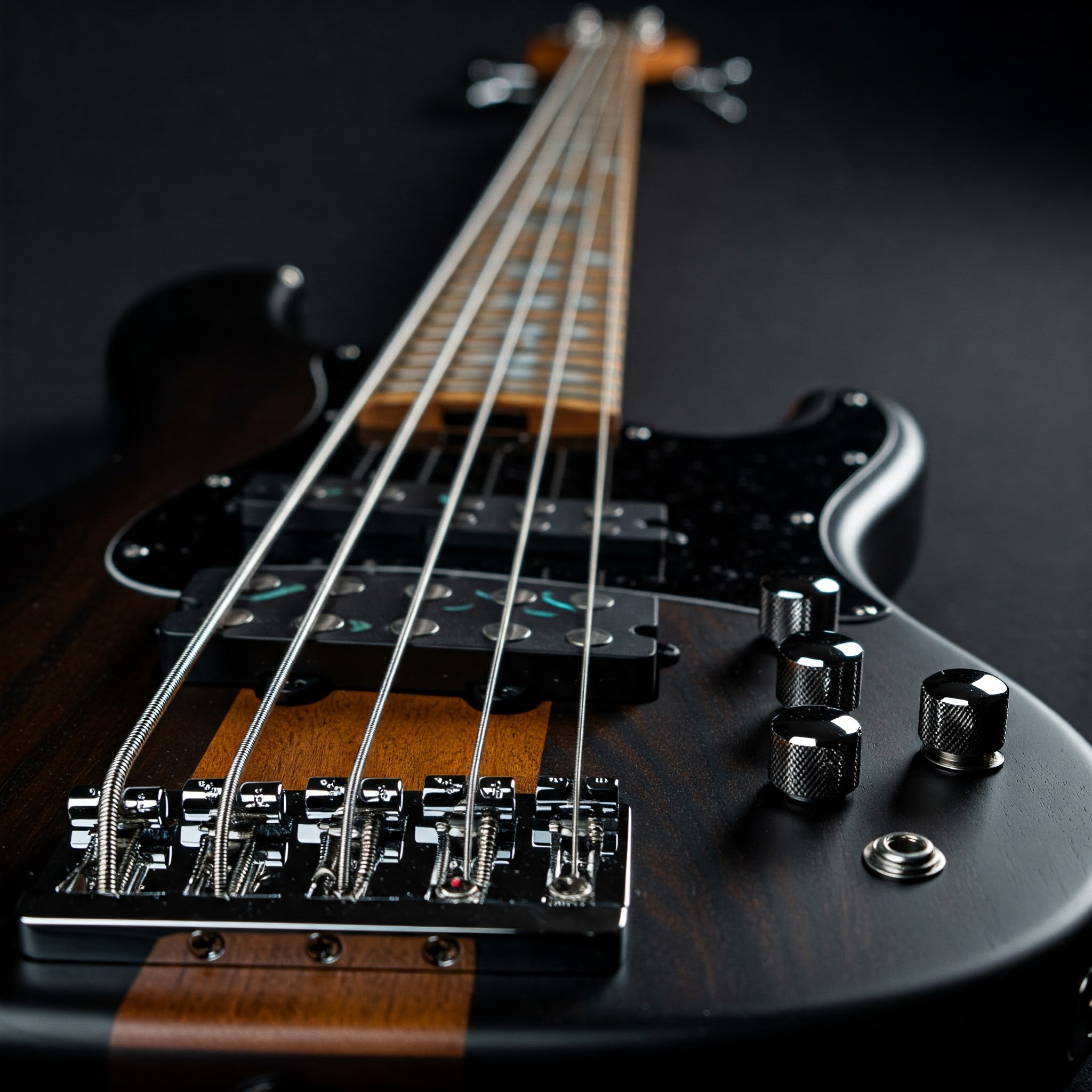Are you tired of the finger noise and bright attack of roundwound strings? Looking for that smooth, warm, old-school thump that defined countless classic recordings? If so, you’ve landed in the right place. Today, we’re diving deep into the world of flatwound bass guitar strings – the secret weapon of countless studio professionals and legendary bassists seeking that perfect mellow tone.
✨Was this helpful? Spread the word! 🚀
As a professional bassist with over 15 years of experience playing everything from jazz to rock to session work, I’ve spent countless hours experimenting with different string types. And I can tell you with confidence that flatwound strings offer a playing experience and tonal palette that simply cannot be matched by their roundwound counterparts.
In this comprehensive guide, we’ll explore everything you need to know about flat wound bass strings – from their unique construction and tonal characteristics to the best brands, maintenance tips, and ideal musical applications. Whether you’re a seasoned pro or a curious beginner, this article will help you understand why flatwounds might be the missing piece in your bass tone puzzle.
Let’s start by comparing flatwound strings with other common bass string types:
| String Type | Tone | Feel | Finger Noise | Longevity | Best For |
|---|---|---|---|---|---|
| Flatwound | Warm, mellow, thumpy | Smooth, polished | Minimal | Very high (years) | Jazz, Motown, classic rock, reggae |
| Roundwound | Bright, punchy, articulate | Textured, rough | High | Moderate (2-6 months) | Rock, metal, slap, modern styles |
| Halfwound | Middle ground | Semi-smooth | Moderate | High | Versatile playing, multiple genres |
| Tapewound | Ultra-smooth, upright-like | Very smooth | Almost none | High | Acoustic upright simulation |
What Are Flatwound Bass Strings?
Flatwound bass guitar strings represent a specific type of string design that differs significantly from the more common roundwound strings found on most modern basses. To understand what makes flatwound strings bass special, we need to look at their unique construction.
The Construction of Flatwound Bass Strings
At their core, flatwound strings share the same basic structure as other bass strings – a core wire wrapped with an outer wire. However, the key difference lies in the profile of that outer wrapping:
- Core Wire: Typically made of steel, though some manufacturers use different materials for tonal variety
- Outer Wrap: Flat ribbon wire polished to a smooth finish (compared to round wire in roundwounds)
- Winding Process: Precision-wound with the flat wire wrapped tightly around the core
This construction method results in a string with an almost completely smooth surface, in stark contrast to the ridged texture of roundwound strings. When you run your finger along a flatwound bass guitar string, you’ll feel virtually no ridges – just a slick, polished surface that feels gentle on your fingertips.
Historical Significance
Flatwound strings aren’t a new innovation – in fact, they were the standard bass string during the 1950s and 1960s. When electric bass was in its infancy, flatwound bass strings provided the warm, thumpy tone that defined the sound of early rock and roll, jazz, and Motown recordings.
Many music historians consider the flatwound string sound to be the “original” electric bass tone. If you listen to recordings from James Jamerson (Motown’s legendary bassist), Paul McCartney’s work with The Beatles, or Duck Dunn’s playing with Booker T. & the M.G.’s, you’re hearing the distinctive sound of flatwound strings.
While roundwound strings eventually became more popular with the rise of rock, funk, and more aggressive playing styles, flatwounds never disappeared. In fact, they’ve experienced a significant resurgence in recent years as bassists rediscover their unique tonal qualities and playing comfort.
The Distinctive Sound and Feel of Flatwound Bass Guitar Strings
What exactly makes flatwound bass guitar strings sound and feel different from other string types? Let’s break down the key characteristics:
Tonal Characteristics
If I had to describe the flatwound sound in one word, it would be “warmth.” But that doesn’t tell the whole story. Here’s a more detailed breakdown:
✅ Low-End Focus: Flatwounds produce a pronounced fundamental note with fewer upper harmonics, resulting in a fat, focused bass tone.
✅ Reduced Sustain: The strings typically have less sustain than roundwounds, creating a more controlled, defined note decay.
✅ Muted Highs: The high frequencies are naturally attenuated, producing a darker overall tone.
✅ Thump Factor: That characteristic “thump” comes from the emphasized fundamental and reduced overtones.
✅ Consistency: The tone tends to remain more consistent as the strings age, unlike roundwounds which can quickly lose their brightness.
The flatwound tone is immediately recognizable to trained ears. It’s the sound of classic Motown hits, jazz recordings, 60s rock and roll, and much of the Beatles’ bass work. It’s a sound that sits perfectly in a mix without fighting for attention, providing a solid foundation that supports rather than competes with other instruments.
Playing Feel
Beyond sound, flat wound bass strings offer a completely different playing experience:
✅ Smooth Surface: The flat winding creates a polished surface that glides under your fingers.
✅ Reduced Finger Noise: The smooth surface virtually eliminates the squeaking and scratching sounds common with roundwounds.
✅ Less Finger Fatigue: Many bassists report less finger soreness during long playing sessions due to the smooth surface.
✅ Consistent Feel: The strings maintain their smooth feel for much longer than roundwounds.
This unique combination of smoothness and reduced finger noise makes flatwounds particularly appealing for studio recording, where unwanted string noise can be problematic. It also makes them ideal for players with sensitive fingertips or those who experience discomfort with roundwound strings.
String Tension
It’s worth noting that flatwound strings typically have higher tension than roundwounds of the same gauge. This increased tension contributes to:
✅ Different Playing Response: The strings feel firmer under your fingers, requiring slightly more effort to play.
✅ Enhanced Note Definition: Notes tend to feel more precise and defined.
✅ Reduced Fret Buzz: The higher tension helps minimize unwanted buzzing.
This higher tension is something to consider when switching to flatwounds for the first time. While some players immediately appreciate the more substantial feel, others may require an adjustment period to get comfortable with the firmer playing experience.
Top Brands and Models of Flatwound Bass Guitar Strings
Not all flatwound bass guitar strings are created equal. Different manufacturers use varying materials, winding techniques, and core designs to create strings with distinct personalities. Here’s a breakdown of some of the most respected brands and their flagship flatwound offerings:
La Bella Deep Talkin’ Bass
La Bella flatwound bass strings stand as perhaps the most legendary option in the flatwound world. These strings have been the go-to choice for countless professional bassists since the 1950s and remain a standard-bearer for traditional flatwound tone.
✅ Tone Profile: Deep, warm, and full-bodied with a pronounced midrange thump and smooth low end.
✅ Construction: Stainless steel flat ribbon wound over a hexagonal steel core.
✅ Feel: Medium-high tension with an exceptionally smooth playing surface.
✅ Longevity: Exceptional durability, with many players reporting years of use from a single set.
✅ Best For: Jazz, traditional rock and roll, reggae, and any style where authentic vintage tone is desired.
What makes La Bella flatwound bass strings special is their authenticity – these strings haven’t changed significantly since the 1950s, delivering the same tone that defined countless classic recordings. They’re not just strings; they’re a direct connection to bass history.
D’Addario Chromes
D’Addario Chromes have earned a reputation as versatile flatwounds that work well across multiple musical styles. They offer the classic flatwound sound with slightly more clarity in the upper midrange.
✅ Tone Profile: Warm and full but with slightly more definition than traditional flatwounds.
✅ Construction: Stainless steel flats wound over hexagonal cores.
✅ Feel: Medium tension with a polished, smooth surface.
✅ Longevity: Very good, with extended life compared to roundwounds.
✅ Best For: Players who want flatwound tone but with a touch more versatility for modern music styles.
The D’Addario Chromes represent an excellent middle-ground option for bassists who want the smoothness and warmth of flatwounds but don’t want to completely sacrifice clarity for modern playing techniques.
Thomastik-Infeld Jazz Flats
For players seeking the ultimate in smooth, sophisticated tone, Thomastik-Infeld Jazz Flats are often considered the gold standard – though they come with a premium price tag to match.
✅ Tone Profile: Incredibly smooth and refined with focused fundamentals and a silky attack.
✅ Construction: Unique nickel alloy flat windings over a nylon core.
✅ Feel: Lower tension than most flatwounds, making them easier to play.
✅ Longevity: Exceptional – many users report 5+ years of regular use.
✅ Best For: Jazz, studio recording, and players seeking the most refined flatwound tone.
These strings are particularly prized for upright bass-like tone and are often the first choice of jazz bassists and studio professionals who demand the most sophisticated sound possible.
Fender 9050 Flatwounds
Fender’s flatwound offerings provide a more accessible entry point into the world of flatwound bass strings while still delivering solid performance.
✅ Tone Profile: Classic warm flatwound tone with slightly brighter characteristics than some competitors.
✅ Construction: Stainless steel ribbon wound over steel cores.
✅ Feel: Medium-high tension with good smoothness.
✅ Longevity: Good durability, though not quite matching the premium options.
✅ Best For: Players on a budget or those trying flatwounds for the first time.
Fender’s flatwounds represent a great starting point for bassists curious about flatwound tone without wanting to invest in more expensive options right away.
Rotosound Jazz Bass 77
Rotosound Jazz 77 strings offer a unique take on the flatwound concept, with a slightly brighter tone than many competitors while still maintaining flatwound characteristics.
✅ Tone Profile: Warm but with more presence and definition than traditional flatwounds.
✅ Construction: Polished stainless steel flatwound over hexagonal cores.
✅ Feel: Medium tension with excellent smoothness.
✅ Longevity: Very good, with extended playing life.
✅ Best For: Jazz fusion, modern jazz, and players who want flatwound feel with a bit more articulation.
The Rotosound Jazz 77s are particularly favored by players who find traditional flatwounds too dark but still want the smooth playing experience.
Here’s a comparison table of these top flatwound bass strings options:
| Brand & Model | Tone | Tension | Price Range | Core Material | Best For |
|---|---|---|---|---|---|
| La Bella Deep Talkin’ Bass | Ultra-warm, vintage | High | $$$$ | Hex steel | Traditional jazz, classic Motown |
| D’Addario Chromes | Warm with clarity | Medium | $$ | Hex steel | Versatile styles |
| Thomastik-Infeld Jazz Flats | Sophisticated, upright-like | Low-Medium | $$$$$ | Nylon | Jazz, studio recording |
| Fender 9050 | Warm, slightly bright | Medium-High | $$ | Steel | Budget-conscious players |
| Rotosound Jazz 77 | Balanced flatwound | Medium | $$$ | Hex steel | Modern jazz, fusion |
💬 Just one click – help others make better buying decisions too! 😊
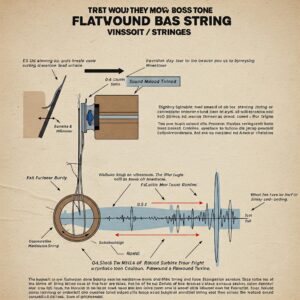
Why Choose Flatwound Bass Guitar Strings?
With so many string options available to modern bassists, you might wonder what specific advantages flatwound bass guitar strings offer. Let’s explore the key benefits that make them the string of choice for many professionals:
1. Superior Comfort and Playability
One of the most immediate benefits you’ll notice when switching to flatwound strings bass is the dramatic improvement in playing comfort:
✅ Smooth Finger Glide: The polished surface allows your fingers to slide effortlessly along the strings.
✅ Reduced Friction: Less resistance means you can play longer without fatigue.
✅ Kind to Fingertips: Players with sensitive fingers often find flatwounds much more comfortable.
✅ Consistent Feel: Unlike roundwounds, which can feel increasingly rough as they age, flatwounds maintain their smooth feel for their entire lifespan.
Bass player James Jamerson, known for his legendary work on countless Motown hits, played exclusively with La Bella flatwound bass strings on his famous 1962 Fender Precision Bass, nicknamed “The Funk Machine.” His intricate, melodic bass lines demonstrate the fluid playability these strings provide.
2. Distinctive Vintage Tone
For many players, the primary appeal of flatwound bass guitar strings is their unmistakable sound:
✅ Warm, Rich Foundation: Perfect for providing a solid harmonic foundation.
✅ Authentic Vintage Character: Instant access to the tones of classic recordings from the 50s and 60s.
✅ Mix-Friendly: The controlled overtones sit perfectly in a mix without competing with other instruments.
✅ Reduced Harshness: The natural roll-off of high frequencies eliminates the need for tone control adjustments in many situations.
When you hear Paul McCartney’s bass work on Beatles classics like “Come Together” or “Something,” you’re experiencing the musical magic of flatwound strings bass – that perfect combination of punch, warmth, and musical weight.
3. Reduced String Noise
For recording situations, flatwound bass guitar strings offer a significant practical advantage:
✅ Minimal Finger Squeaks: The smooth surface dramatically reduces the string noise that can plague roundwound recordings.
✅ Clean Slides: Position shifts produce much less unwanted noise.
✅ Less EQ Work: Engineers often appreciate the reduced need for noise reduction and EQ work.
✅ Consistent Performance: Dependable noise characteristics throughout long recording sessions.
This reduced noise factor makes flatwounds particularly valued in studio environments, where clean, controlled bass tracks are essential.
4. Exceptional Longevity
While the initial investment in quality flat wound bass strings may be higher than roundwounds, their extraordinary lifespan often makes them more economical in the long run:
✅ Multi-Year Durability: Many players report using the same set for 3-5 years or more.
✅ Stable Tone: Unlike roundwounds, which quickly lose their initial brightness, flatwounds maintain consistent tone throughout their life.
✅ Corrosion Resistance: The smooth surface provides less opportunity for dirt and oil to accumulate.
✅ Value Proposition: Higher upfront cost but lower cost per year of use.
Consider this: While you might replace roundwound strings every 2-3 months to maintain fresh tone, a good set of flatwound bass guitar strings might last 5 years with similar performance throughout. The math often favors flatwounds for serious players.
5. Reduced Fingerboard Wear
The smooth construction of flatwound strings bass offers a hidden benefit for your instrument as well:
✅ Less Fret Wear: The smoother surface causes less abrasion against frets.
✅ Fingerboard Protection: Reduced scoring and marking on softer fingerboard woods.
✅ Sustained Playability: Helps maintain consistent action and playability over time.
This protection factor can be particularly important for vintage instruments or basses with softer fingerboard materials like rosewood or pau ferro.
Musical Styles Best Suited for Flatwound Bass Guitar Strings
While flatwound bass guitar strings can be used for any style of music – and many players do exactly that – they have traditionally been associated with certain genres where their unique characteristics shine brightest:
Jazz and Jazz Fusion
The sophisticated, warm tone of flatwound strings bass has made them a perennial favorite among jazz bassists:
✅ Walking Bass Lines: The focused fundamental and quick decay help each note in a walking line stand distinct.
✅ Upright-Like Quality: Players seeking an acoustic bass-like sound often prefer flatwounds.
✅ Finger-Style Clarity: Clean articulation without excessive string noise.
✅ Studio Versatility: The controlled overtones work well in complex jazz arrangements.
Legendary jazz bassists like Ron Carter, Dave Holland, and Christian McBride have all used flatwound bass guitar strings extensively throughout their careers, contributing to the definitive sound of modern jazz bass.
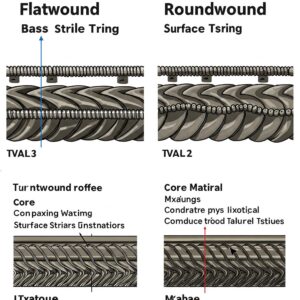
Motown and Classic R&B
The iconic Motown bass sound that defined an era is inseparable from flatwound bass strings:
✅ Rhythmic Foundation: The perfect balance of punch and warmth supports driving R&B grooves.
✅ Note Definition: Clear articulation even in busy patterns.
✅ Vintage Authenticity: The genuine sound of 60s and 70s soul and R&B recordings.
✅ Harmonic Complexity: Flatwounds allow subtle nuances in R&B bass lines to shine through.
Motown’s house bassist James Jamerson exclusively used La Bella flatwound bass strings on his 1962 Precision Bass, creating the foundation for hundreds of hit records with their distinctive warm thump.
Reggae and Dub
Reggae bass players have long favored flat wound bass strings for their unique properties:
✅ Deep Foundation: The emphasized low end supports reggae’s bass-centric approach.
✅ Controlled Decay: Perfect for the short, punchy notes characteristic of reggae basslines.
✅ Warm Presence: Flatwounds provide the ideal tonal foundation for reggae’s rhythm section.
✅ Studio Performance: The reduced finger noise works well with reggae production techniques.
Legendary reggae bassist Aston “Family Man” Barrett of Bob Marley and the Wailers used flatwound strings bass to create the hypnotic, room-shaking bass lines that defined reggae music.
Classic Rock and Blues
Many classic rock and blues bassists have relied on flatwound bass guitar strings for their foundational sound:
✅ Vintage Authenticity: The genuine sound of early rock and roll and blues recordings.
✅ Harmonic Balance: Cuts through a mix without competing with guitars.
✅ Reduced Harshness: Smoother tone that complements tube amplification.
✅ Dynamic Response: Excellent sensitivity to playing dynamics.
From Duck Dunn’s work with Booker T. & the M.G.’s to Jack Bruce’s groundbreaking playing with Cream, flatwound bass strings helped define the sound of early rock and blues bass.
Studio Session Work
Professional session bassists often choose flatwound bass guitar strings for their predictable performance characteristics:
✅ Consistent Tone: Reliable sound from session to session.
✅ Minimal Noise: Clean tracks that require less engineering intervention.
✅ Mix-Friendly: Sits well in complex arrangements without frequency conflicts.
✅ Versatile Foundation: Works across multiple musical styles.
Many of the most recorded bassists in history, including Carol Kaye of the legendary Wrecking Crew studio musicians, relied on flatwound strings bass for countless hit recordings spanning multiple genres.
📦 Top Recommended Flatwound Bass Strings You Can Buy Today 📦
After extensive testing and research, I’ve identified the top flatwound string sets that deliver exceptional performance across different playing needs and budgets. Here are my top recommendations:
1. D’Addario ECB81S Chromes Bass Guitar Strings
These medium-gauge flatwounds (45-100) offer an excellent balance of traditional flatwound tone with slightly more clarity than other options. The polished chrome surface provides exceptional smoothness while maintaining good tension and response.
Key Features:
- Stainless steel flatwound construction
- Balanced tension for comfortable playability
- Excellent longevity
- Made in the USA with precise digital winding technology
- Perfect middle ground between vintage and modern tones
These D’Addario Chromes represent an ideal starting point for players new to flatwounds, offering the classic warm tone while retaining enough definition for versatile playing styles.
2. La Bella 760FS Deep Talkin’ Bass Flatwound Strings
For the most authentic vintage flatwound experience, these La Bella flatwound bass strings are virtually unmatched. They deliver the exact tone that defined countless classic recordings from the 50s and 60s with an ultra-smooth feel and deep, warm sound.
Key Features:
- Traditional construction unchanged since the 1950s
- Deep, thumpy fundamental with controlled overtones
- Exceptional hand feel with minimal finger noise
- Higher tension for defined notes and reduced buzzing
- Extraordinary longevity measured in years rather than months
These strings are the gold standard for jazz, classic rock, and Motown styles, providing that unmistakable vintage thump that sits perfectly in any mix.
3. GHS Precision Flats Medium Flatwound Bass Strings
These strings offer a unique middle ground between traditional flatwounds and roundwounds, with a bit more brightness while maintaining the smooth surface and reduced finger noise of flats.
Key Features:
- Slightly brighter tone than traditional flatwounds
- Smooth surface with minimal finger noise
- Medium tension for comfortable playability
- Excellent note definition while maintaining warmth
- Good value for the quality
The GHS Precision Flats are perfect for players who want the comfort of flatwounds but need a bit more high-end definition for more contemporary musical styles.
4. Thomastik-Infeld JF344 Jazz Flat Wound Bass Strings
At the premium end of the spectrum, these exceptional strings deliver perhaps the most sophisticated flatwound tone available, with an almost piano-like quality that’s ideal for jazz and sophisticated session work.
Key Features:
- Unique nickel tape winding over nylon core
- Extraordinarily smooth feel with lower tension than steel-core flatwounds
- Sophisticated tone with perfect balance of warmth and definition
- Minimal finger noise for studio work
- Unmatched longevity (5+ years of regular use reported by many players)
While commanding a premium price, these strings deliver a playing experience and tonal quality that many professional bassists consider worth every penny.
5. Fender 9050 Stainless Flatwound Bass Strings
For players on a budget who want to experience flatwound tone without a major investment, these Fender flatwounds offer good performance at a more accessible price point.
Key Features:
- Stainless steel construction with smooth surface
- Classic flatwound tone with slightly brighter character
- Medium tension for comfortable playability
- Good durability for the price point
- Authentic Fender heritage
These make an excellent entry point into the world of flatwounds for players curious about the tone but not ready to invest in more expensive options.
Comparison of Recommended Flatwound Bass Strings
| String Set | Price Range | Tension | Brightness | Longevity | Best For |
|---|---|---|---|---|---|
| D’Addario ECB81S | $$ | Medium | Medium-Low | Very Good | Versatile use, first-time flatwound users |
| La Bella 760FS | $$$$ | High | Low | Excellent | Authentic vintage tone, jazz, Motown |
| GHS Precision Flats | $$ | Medium | Medium | Good | Multiple genres, transitioning from roundwounds |
| Thomastik-Infeld JF344 | $$$$$ | Low-Medium | Low-Medium | Outstanding | Jazz, studio recording, sophisticated tone |
| Fender 9050 | $$ | Medium-High | Medium-Low | Good | Budget option, beginners to flatwounds |
💬 Just one click – help others make better buying decisions too! 😊
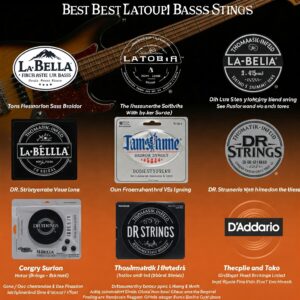
How to Get the Most from Your Flatwound Bass Guitar Strings
To maximize the performance and lifespan of your flatwound bass guitar strings, consider these essential tips:
Proper Installation and Break-In
Unlike roundwound strings, flatwound strings bass have some specific installation considerations:
✅ Careful Winding: Wind the strings neatly around the tuning posts to avoid kinks or overlap.
✅ Initial Stretching: Gently stretch new flatwounds to help them stabilize faster.
✅ Break-In Period: Allow 10-15 hours of playing time for the strings to settle and reveal their true tone.
✅ Tuning Stability: Check tuning more frequently during the first week as the strings adapt.
Many players note that flatwound bass guitar strings don’t reach their optimal tone immediately after installation. Be patient during the break-in period – the strings will typically become warmer and more balanced as they settle in.
Maintenance Practices
The legendary longevity of flatwound bass strings can be further extended with proper care:
✅ Regular Cleaning: Wipe strings down with a clean cloth after each playing session.
✅ Hand Washing: Clean hands before playing reduces oil and dirt transfer.
✅ Occasional Deep Cleaning: Using specialized string cleaners every few months can remove built-up deposits.
✅ Humidity Control: Store your bass in controlled humidity to prevent corrosion.
While flatwound bass guitar strings are naturally resistant to dirt and oil buildup due to their smooth surface, regular maintenance will ensure they maintain optimal tone and feel for years.
Amplification and EQ Considerations
To get the most from your flat wound bass strings, consider adjusting your amplification approach:
✅ Bass Boost Moderation: Flatwounds already emphasize low end, so use EQ boosts sparingly.
✅ Midrange Focus: A slight bump in upper mids (800Hz-1.5kHz) can add definition without harshness.
✅ Compression Settings: Flatwounds often benefit from less compression than roundwounds.
✅ Tube vs. Solid State: Many flatwound players prefer tube preamps for additional warmth and character.
The natural tonal characteristics of flatwound bass guitar strings often require less processing to sit well in a mix, making them particularly appreciated by recording engineers.
📢 Transform Your Bass Sound Today with Premium Flatwounds! ✨
Ready to experience the smooth feel and warm, thumping tone that only quality flatwound strings can deliver? The strings we’ve recommended represent the best options on the market, each with their own unique tonal signature and playing characteristics. Whether you’re looking for authentic vintage tone or a more versatile modern approach, there’s a flatwound set perfect for your playing style.
➡ Click on any of the highlighted product recommendations to check current pricing and availability. Your fingers and ears will thank you!
Flatwound vs. Roundwound: Making the Right Choice
While flatwound bass guitar strings offer numerous advantages, they’re not necessarily the right choice for every player or musical situation. Let’s compare them directly with roundwounds to help you make an informed decision:
Tone Comparison
The most obvious difference between these string types lies in their tonal characteristics:
| Characteristic | Flatwound | Roundwound |
|---|---|---|
| Fundamental Strength | Stronger | Moderate |
| High Frequency Content | Limited | Abundant |
| Harmonic Complexity | Focused | Complex |
| Note Decay | Faster | Extended |
| Tonal Stability Over Time | Very Stable | Changes Significantly |
Flatwound strings bass provide a consistent, warm foundation that works perfectly for supportive playing but may lack the cutting power needed for certain contemporary styles.
Playing Technique Considerations
Your preferred playing techniques should influence your string choice:
| Technique | Flatwound Suitability | Roundwound Suitability |
|---|---|---|
| Fingerstyle | Excellent | Good |
| Pick Playing | Good | Excellent |
| Slap & Pop | Limited | Excellent |
| Tapping | Limited | Good |
| Harmonics | Good (fundamental) | Excellent (overtones) |
If slap bass or other percussive techniques form a significant part of your playing style, flatwound bass guitar strings may not be the optimal choice despite their other advantages.
Instrument Considerations
The bass guitar itself can influence how well flatwound strings bass will work for you:
✅ Scale Length: Flatwounds tend to work particularly well on standard 34″ scale basses.
✅ Pickup Type: P-style split pickups often pair beautifully with flatwounds.
✅ Wood Combinations: Warmer-sounding woods (like ash bodies with rosewood fingerboards) complement flatwounds nicely.
✅ Neck Profile: The higher tension of flatwounds feels different on various neck profiles.
While flatwounds can work on virtually any bass, certain instrument configurations particularly showcase their unique qualities.
Making the Transition
If you’re considering switching from roundwounds to flatwound bass guitar strings, be prepared for an adjustment period:
✅ Tension Adaptation: Your fingers will need time to adjust to the typically higher tension.
✅ Technique Refinement: Some techniques may require modification with the smoother surface.
✅ Tonal Expectations: Give yourself time to appreciate the different character rather than expecting the same sound with less noise.
✅ Setup Considerations: You might need minor truss rod or action adjustments due to the different string tensions.
Many players report an initial period of uncertainty when switching to flat wound bass strings, followed by a moment of revelation when everything clicks and they discover a whole new dimension to their playing.
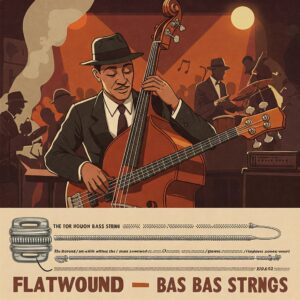
Exploring Popular Flatwound Bass String Gauges
The gauge (thickness) of your flatwound bass guitar strings can significantly impact both tone and playability. Let’s examine the most common options:
Light Gauge (40-95 or similar)
✅ Playability: Easier on the fingers, lower tension.
✅ Tone: Slightly less low-end power but often with better definition.
✅ Response: Quicker response with less effort required.
✅ Best For: Players with hand issues, vintage basses that can’t handle high tension, or those seeking easier playability.
Light gauge flatwound strings bass can be an excellent choice for players transitioning from roundwounds who want to ease into the typically higher tension of flats.
Medium Gauge (45-105 or similar)
✅ Playability: Balanced tension that most players find comfortable.
✅ Tone: Good balance of low-end power and definition.
✅ Response: Responsive while still providing substantial feel.
✅ Best For: Most players and musical styles – a versatile middle ground.
Medium gauge represents the most popular choice for flatwound bass guitar strings, offering a good balance of tone and comfort for most applications.
Heavy Gauge (50-110 or similar)
✅ Playability: Higher tension requiring more finger strength.
✅ Tone: Maximum low-end power and pronounced fundamental.
✅ Response: More controlled with excellent note definition.
✅ Best For: Jazz, reggae, and styles where maximum bottom end is desired.
Heavy gauge flat wound bass strings deliver the most authoritative low end but require stronger hands and instruments that can handle the increased tension.
5-String and Extended Range Options
For extended range basses, flatwound bass guitar strings are available in appropriate configurations:
✅ 5-String Sets: Typically ranging from 45-130, with the B string providing exceptional low-end foundation.
✅ 6-String Sets: Usually 30-130, offering both extended low and high range options.
✅ Custom Options: Many manufacturers offer custom gauge combinations for specific needs.
The low B on a 5-string bass particularly benefits from the focused fundamental that flatwound strings bass provide, delivering a clear, defined bottom end that can be difficult to achieve with roundwounds.
Advanced Flatwound String Options and Innovations
While traditional flatwound bass guitar strings remain popular, manufacturers have introduced several innovations worth exploring:
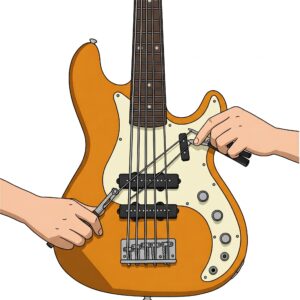
Tapewound Strings
Taking the smooth concept even further, tapewound strings feature a nylon tape outer wrap:
✅ Tone: Ultra-warm, almost upright-like sound.
✅ Feel: Exceptionally smooth, even compared to standard flatwounds.
✅ Noise: Virtually silent, with almost no finger noise.
✅ Applications: Ideal for upright bass simulation and ultra-quiet recording situations.
Tapewound strings like the La Bella 760N Black Nylon Tape series offer perhaps the smoothest playing experience available, though with some sacrifice in brightness and articulation.
Pressure Wound Strings
A middle ground between flat and roundwound, pressure wound (or ground wound) strings offer an interesting compromise:
✅ Construction: Round windings that have been pressed or ground partially flat.
✅ Tone: Warmer than roundwounds but brighter than true flatwounds.
✅ Feel: Smoother than rounds but with more texture than flats.
✅ Best For: Players seeking a hybrid tone with balanced characteristics.
Options like DR Strings Legends offer a compromise that works well for players who find traditional flatwound bass guitar strings too dark but appreciate their smoother feel.
Coated Flatwound Strings
Some manufacturers now offer coated versions of their flatwound strings bass for additional protection:
✅ Corrosion Resistance: Extra protection against sweat and humidity.
✅ Longevity: Even longer lifespan than standard flatwounds.
✅ Tone: Slightly more subdued initial sound but with excellent stability.
✅ Feel: Extra smooth with a slightly different tactile experience.
These specialized strings can be particularly valuable for players who tour in varying climates or have particularly acidic perspiration that might compromise even standard flatwounds.
Common Myths About Flatwound Bass Guitar Strings
Despite their long history, several misconceptions about flatwound bass guitar strings persist. Let’s address some of the most common myths:
Myth #1: “Flatwounds are only for jazz players”
While flatwounds are indeed popular among jazz bassists, they’ve been used across virtually every genre:
✅ Rock: Paul McCartney (The Beatles) used flatwounds on many classic recordings.
✅ R&B/Soul: James Jamerson’s iconic Motown bass lines were played on flatwounds.
✅ Reggae: Most classic reggae bassists relied on flatwounds for their signature sound.
✅ Blues: Duck Dunn of Booker T. & the M.G.’s used flatwounds extensively.
✅ Modern Indie: Many contemporary bands use flatwounds for their warm, vintage character.
Flatwound bass guitar strings are versatile tools that can work in any genre where their particular tonal characteristics are desired.
Myth #2: “Flatwounds have no sustain”
While flatwound bass strings typically have less sustain than roundwounds, this isn’t necessarily a limitation:
✅ Controlled Decay: The faster decay can actually help define notes in busy passages.
✅ Amplification Impact: Modern amplification can easily compensate if more sustain is desired.
✅ Technique Adaptation: Playing style adjustments can maximize the sustain available.
✅ Bass Construction Factors: The instrument itself often has more impact on sustain than string type.
Many players actually prefer the more controlled note decay of flatwounds, finding it helps create cleaner, more defined bass lines.
Myth #3: “Flatwounds are too hard to play”
The higher tension of flatwound bass guitar strings can be an adjustment, but not necessarily a drawback:
✅ Gauge Options: Lighter gauge flatwounds can offer lower tension for easier playability.
✅ Adaptation Period: Most players adjust to the feel within a few weeks of regular playing.
✅ Setup Optimization: Proper bass setup can make flatwounds feel much more comfortable.
✅ Technique Benefits: The higher tension can actually improve playing precision over time.
While there is an adjustment period when switching to flat wound bass strings, many players eventually find they prefer the more substantial feel once they’ve adapted to it.
Myth #4: “Flatwounds don’t work for recording”
This common misconception is actually the opposite of reality:
✅ Studio Favorite: Many recording engineers specifically request flatwounds for their predictable tone and reduced noise.
✅ Mix-Friendly: Flatwounds often require less processing to sit properly in a complex mix.
✅ Noise Reduction: The dramatic reduction in finger noise makes for cleaner tracks.
✅ Tonal Consistency: Their stable tone throughout a recording session is highly valued.
Far from being problematic for recording, flatwound bass guitar strings are often the preferred choice for professional studio situations.
💫 Ready to Transform Your Bass Sound? Try Premium Flatwounds Today! 🎸
➡ Whether you’re seeking that authentic vintage thump, looking to reduce finger noise in recordings, or simply want to experience the legendary comfort of flatwound strings, the options we’ve highlighted represent the best the market has to offer. Click on any of our recommended products to check current pricing and availability!
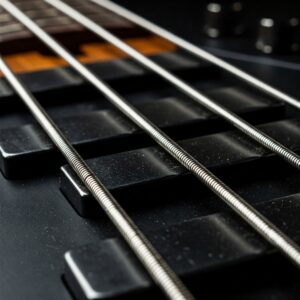
Conclusion: Are Flatwound Bass Guitar Strings Right for You?
After exploring the world of flatwound bass guitar strings in detail, the question remains: should you make the switch? The answer depends on your personal preferences, playing style, and musical goals.
Flatwound strings bass offer undeniable advantages:
✅ Distinctive warm, vintage tone that’s immediately recognizable
✅ Exceptional comfort and reduced finger fatigue during extended playing
✅ Dramatic reduction in string noise for clean recordings
✅ Outstanding longevity measured in years rather than months
✅ Authentic connection to bass history and classic recordings
However, they also come with considerations:
❌ Higher initial cost (though potentially better long-term value)
❌ Limited effectiveness for certain techniques like slapping
❌ Less brightness and articulation for modern styles
❌ Adjustment period for players accustomed to roundwounds
For many bassists, the solution lies in having multiple instruments strung differently or keeping an extra set of each string type for different musical situations. But even if you’re working with a single bass, flatwound bass guitar strings offer a sonic palette worth exploring.
I encourage you to try a quality set of flatwounds if you haven’t already experienced their unique characteristics. You might just discover a whole new dimension to your bass playing and tone that opens creative possibilities you hadn’t imagined.
FAQs About Flatwound Bass Guitar Strings
❓ How long do flatwound bass guitar strings last compared to roundwounds?
✅ Flatwound bass strings typically last 3-5 times longer than roundwounds, with many players reporting 2-5 years of regular use from a single set. Their smooth construction resists corrosion and maintains consistent tone throughout their lifespan...
❓ Can I slap bass effectively with flatwound bass strings?
✅ While possible, slap technique is challenging with flatwound bass guitar strings due to their smooth surface and reduced brightness. They lack the characteristic snap that roundwounds provide, but some players do develop modified slap techniques that work with flatwounds...
❓ What's the best way to clean flatwound bass strings?
✅ For flatwound strings bass, wipe down with a microfiber cloth after each session and occasionally use a specialized string cleaner that doesn't leave residue. Their smooth surface makes them easier to clean than roundwounds, helping them maintain tone longer...
❓ Do I need to adjust my bass setup when switching to flatwound bass strings?
✅ Yes, minor adjustments are typically needed when switching to flatwound bass guitar strings due to their different tension and response. Expect to adjust truss rod tension and possibly string height at the bridge to optimize playability and prevent buzzing...
❓ Which flatwound bass strings are best for beginners trying them for the first time?
✅ D'Addario Chromes and Fender 9050 flatwound bass strings offer excellent entry points for beginners due to their moderate price, balanced tone, and manageable tension. These strings provide the classic flatwound experience while being more forgiving than some higher-tension options...
Recommended for You:
- 7 Best 6 String Fretless Bass Options That Will Transform Your Sound in 2025
- 10 Amazing Yamaha 5 String Bass Options That Will Transform Your Sound in 2025
- 10 Best Short Scale 5 String Bass Options for Compact Powerhouse Playing in 2025
Disclaimer: This article contains affiliate links. If you purchase products through these links, we may earn a small commission at no additional cost to you.
✨ Found this helpful? Share it with your friends! 💬🤗

